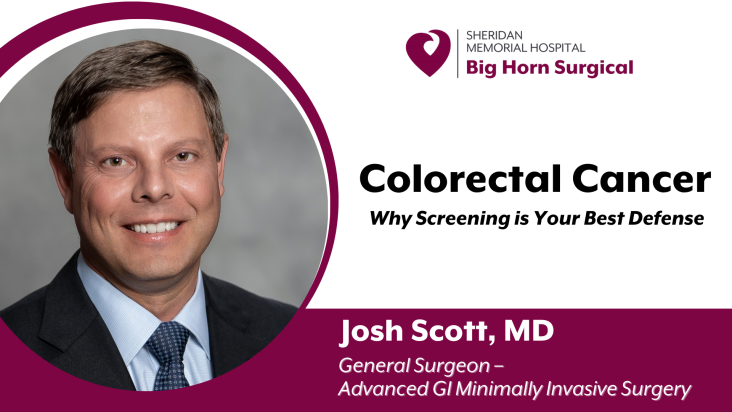By Joshua Scott, MD – General Surgeon – Advanced GI Minimally Invasive Surgery – Big Horn Surgical
March is National Colon Cancer Awareness Month, an appropriate time to explore this topic. Colon or Colorectal Cancer (CRC) is one of the most common cancers in the United States and the second leading cause of cancer death behind lung cancer.
Screening is recommended simply because it can detect colorectal cancer early and prevent unnecessary deaths. Colorectal cancer incidence and mortality rates have been declining in the US, likely due to the increasing screening uptake.
Since colorectal cancers typically don’t produce symptoms, the practice of screening enables us to look for cancer or precancerous lesions in individuals without symptoms. Screening is incredibly effective when it comes to colorectal cancer because, from the time the first abnormal cells start to develop, it takes an average of 10-15 years for those cells to become a colorectal cancer. Therefore, as one of the most effective tools for preventing colorectal cancer, screening allows us to find and remove precancerous lesions such as polyps and help identify people who would benefit from more frequent screenings. In addition, small cancers that aren’t yet big enough to produce symptoms can also be identified.
The US Preventive Services Task Force recommends adults between the ages of 45 and 75 be screened for colorectal cancer. Although most cases of CRC occur over the age of 50, initiating screening at age 45 balances the benefits of detection and prevention with the burden on the patient and the risk of harm from screening. If you are older than 75, it is recommended that you talk to your doctor about the necessity of continued screening.
There are reasons to start screening earlier or stop later for some people. It is estimated that only about two-thirds of adults in the US are up to date with colorectal cancer screening. Every year, about 140,000 people in the US will be diagnosed with colorectal cancer, and 50,000 people will die from it. Our best tool to decrease both of these numbers is screening.
Risk Factors
The risk of colorectal cancer increases with age, with more than 90% of the cases we see being diagnosed in people age 50 or older. Many factors are associated with an increased risk of colorectal cancer. Some of these risk factors are related to lifestyle choices and are, therefore, modifiable. Maintaining a healthy weight, being physically active, not smoking or chewing tobacco, avoiding heavy alcohol intake, and eating a balanced diet that limits red or processed meat intake can all help decrease your risk of colorectal cancer.
Colorectal cancer can cause symptoms as it grows. These symptoms include seeing blood in or on your stool, unintentional weight loss, a change in bowel habits and weakness or fatigue caused by a low blood count.
Types of CRC Screenings
There are several screening tools for colorectal cancer, including tests done on your stool and colonoscopy. The stool-based studies either look for evidence of trace blood that can’t be seen by the naked eye or look for altered DNA that can be associated with abnormal cells in the colon. Stool-based studies that look for blood must be repeated annually if negative. A negative stool DNA test needs to be repeated every three years. However, if a stool-based test results with a positive outcome, it will need to be followed up with a colonoscopy. Stool-based studies are only appropriate for patients with an average risk of colorectal cancer. Average-risk individuals are those who have no personal or family history of adenomatous polyps or colorectal cancer or other risk factors such as inflammatory bowel disease like ulcerative colitis or a genetic predisposition.
A colonoscopy is a procedure that uses a fiber-optic tube and air to examine the colon’s lining. Colonoscopy allows for the identification of polyps and their removal, or biopsy if the polyp is too large, at the same time as the procedure.
Depending on the findings during the procedure and individual risk factors, a colonoscopy may be repeated every year for high-risk individuals to a more typical range of 7 to 10 years.
For many, the worst part of a colonoscopy is the bowel prep, which is done at home the evening and morning before the procedure. The bowel prep cleans out the colon so it can be adequately examined during the colonoscopy. A good bowel prep is essential to getting a good colonoscopy as it helps the doctor detect and remove polyps more easily.
The colonoscopy itself doesn’t hurt. Patients are given sedating medication, which helps with discomfort, and many patients won’t remember having the procedure once it’s complete. Colonoscopy patients will need a friend or family member to drive them home after the procedure. Typically a patient will be able to eat and drink normally afterward.
Reach out to your physician or provider to talk about your risk factors. Discussing these factors in advance can help identify the most effective and appropriate screening test for you.
To Find a Doctor and their contact information click HERE — https://www.sheridanhospital.org/find-a-doctor/.

